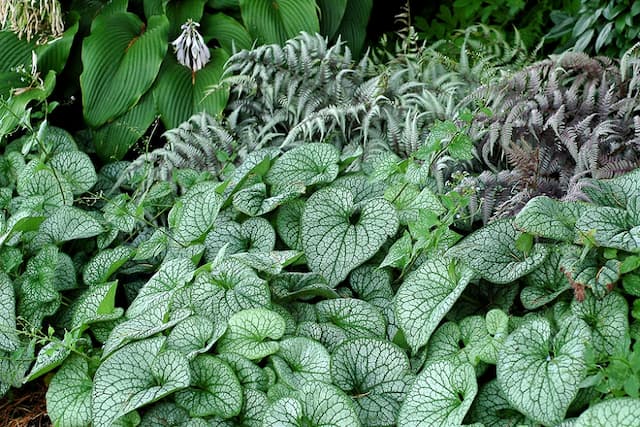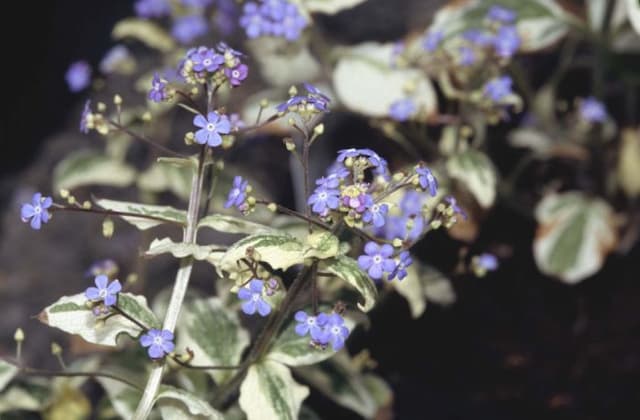Honeywort Cerinthe major 'Purpurascens'

ABOUT
Cerinthe major 'Purpurascens', commonly known as Honeywort, is an attractive plant renowned for its unique coloration and structure. One of the most eye-catching features of Honeywort is its blue-green foliage that gracefully arches, creating a smooth, almost drooping effect. The leaves encase the stem and are often aligned in a shingle-like fashion, adding to the plant's visual interest. What truly sets Honeywort apart are its stunning flowers and bracts. The flowers themselves are tubular, elegantly hanging in clusters from the top of the stems. They exhibit a rich purple to deep blue hue, sometimes accentuated with a touch of creamy yellow at the tips where they emerge from the protective bracts. The bracts are equally remarkable, contributing a bold color contrast that commands attention. These modified leaves are colored in shades of purplish-blue, often edged or highlighted with striking blue or even indigo pigments that make the entire flowering tip of the plant stand out exquisitely against the greenery. During the flowering season, Honeywort becomes a focal point in any garden, with its cascade of colors that seem to blend harmoniously with each other. While offering its splendid appearance, it also attracts a variety of pollinators such as bees, who are drawn to its nectar-rich blooms. The beauty of Honeywort can be fully appreciated when it is planted in mass or when it spills delicately from containers, showcasing its vivid flowers and artful foliage.
About this plant
 Names
NamesSynonyms
Honeywort, Blue Shrimp Plant, Pride Of Gibraltar, Purple Wax Flower
Common names
Cerinthe major 'Purpurascens'.
 Toxicity
ToxicityTo humans
Honeywort is not known to be toxic to humans. Therefore, ingestion of this plant should not cause any harmful symptoms of poisoning; however, it is always advisable to avoid consuming plants that are not typically recognized as edible due to potential individual allergic reactions or other unforeseen consequences.
To pets
Honeywort is also not known to be toxic to pets, which means that if a pet were to ingest this plant, it should not typically experience any symptoms of poisoning. As with humans, it is still recommended to prevent pets from consuming non-food plants to avoid the risk of stomach upset or other individual adverse reactions.
 Characteristics
CharacteristicsLife cycle
Annuals
Foliage type
Deciduous
Color of leaves
Blue-green
Flower color
Purple
Height
1-2 feet (30-60 cm)
Spread
0-1 feet (0-30 cm)
Plant type
Herb
Hardiness zones
7
Native area
Mediterranean
Benefits
 General Benefits
General Benefits- Attracts Pollinators: Honeywort is a favorite among bees and hummingbirds, helping to promote pollination in the garden.
- Low Maintenance: Honeywort is known for being easy to care for and does not require frequent watering or fertilizing.
- Drought Tolerant: Once established, Honeywort can withstand periods of drought, making it suitable for xeriscaping.
- Aesthetic Appeal: With its striking blue-green foliage and deep purple hanging flowers, Honeywort adds unique color and texture to gardens.
- Seasonal Interest: It provides visual interest from spring to fall, maintaining its beauty across the seasons.
- Deer Resistant: Honeywort is typically not favored by deer, making it a good choice for gardens in areas with deer populations.
- Edible Ornamental: Some parts of the Honeywort plant are edible, adding a unique flavor to salads and dishes.
- Great for Containers: Its compact size and ornamental qualities make Honeywort suitable for container gardening.
 Medical Properties
Medical PropertiesThis plant is not used for medical purposes.
 Air-purifying Qualities
Air-purifying QualitiesThis plant is not specifically known for air purifying qualities.
 Other Uses
Other Uses- Honeybee Attraction: Cerinthe major 'Purpurascens', commonly known as honeywort, is an excellent plant for attracting honeybees due to its abundant nectar, helping to support local pollinator populations.
- Dye Production: The bracts and foliage of honeywort can be used to produce a natural dye for textiles, yielding shades of yellow to green depending on the mordant used.
- Floral Arrangements: Fresh or dried, the unique shape and color of honeywort's flowers and bracts offer an unusual touch to floral arrangements and bouquets.
- Garden Borders: Honeywort's drooping bell-shaped flowers and bluish-green foliage make it a distinctive choice for garden borders and edges.
- Photography Subject: The striking appearance of honeywort makes it a popular subject for botanical photographers and plant enthusiasts.
- Educational Use: In gardens and schools, honeywort can be used to teach students and visitors about plant-pollinator relationships.
- Craft Projects: The sturdy stems and attractive flowers of honeywort can be incorporated into various craft projects, including wreaths and table decorations.
- Companion Planting: Honeywort can be planted alongside vegetables and fruit trees as a companion plant to improve pollination of crops.
- Garden Themed Artwork: The unique structure and coloration of honeywort inspire artists to feature this plant in garden themed paintings and illustrations.
- Seed Saving: Garden enthusiasts often collect seeds from honeywort as it readily self-sows, which can be shared or used to grow new plants in subsequent seasons.
Interesting Facts
 Feng Shui
Feng ShuiThe Honeywort is not used in Feng Shui practice.
 Zodiac Sign Compitability
Zodiac Sign CompitabilityThe Honeywort is not used in astrology practice.
 Plant Symbolism
Plant Symbolism- Attraction: The nodding, tubular flowers and rich purple-blue bracts of Honeywort (the common name for Cerinthe major 'Purpurascens') are said to symbolize attraction, drawing in both the eye of an admirer and pollinators in the garden.
- Mystery: Its unique appearance and unusual coloration can represent mystery or the uncommon, drawing a parallel with things that are not easily understood or mysterious in nature.
- Flexibility: The way Honeywort adapts to various soil types and its drooping growth habit symbolize flexibility and the ability to thrive in different situations or environments.
- Harmony with nature: With its attractiveness to bees and other pollinators, Honeywort is often associated with a garden in harmony with nature, symbolizing ecological balance and the importance of natural relationships.
 Water
WaterHoneywort prefers consistently moist but not waterlogged soil. During the growing season, water the plant thoroughly once the top inch of soil begins to dry out, which may mean watering once every few days to a week, depending on weather conditions. Use about 16 ounces of water for small pots or up to 2 gallons for larger garden areas every time you water, adjusting the amount as necessary for the size of your plant and environmental factors. It's important to ensure that the pot or ground where Honeywort is planted has good drainage to prevent root rot.
 Light
LightHoneywort thrives best in full sun to partial shade. Place the plant in a spot where it will receive at least six hours of sunlight daily. An east- or west-facing garden or window will provide the ideal light conditions, giving Honeywort the right balance of light to flourish without experiencing the intense midday sun, which might be too harsh, especially in hotter climates.
 Temperature
TemperatureHoneywort can handle a range of temperatures and is hardy in USDA Zones 7 to 9. The ideal temperature for growing Honeywort is between 50°F and 75°F. The plant can survive minimum temperatures down to 20°F and maximum temperatures of around 80°F, but prolonged exposure to extremes can be harmful. Therefore, it's advisable to provide some protection or bring the plant indoors during severe cold or heatwaves.
 Pruning
PruningPruning Honeywort is mainly done to encourage bushiness and prevent the plant from becoming leggy. It's best to prune lightly throughout the growing season by pinching off the tips of the stems, which stimulates lateral growth. The ideal time to prune is in the spring as new growth appears. There's no need for heavy pruning; regular light maintenance is sufficient.
 Cleaning
CleaningAs needed
 Soil
SoilHoneywort requires well-draining soil with a neutral to slightly alkaline pH, around 7.0 to 7.5. A mix of regular garden soil, compost, and perlite or sand can provide the necessary drainage and nutrients. It is important to avoid soil that retains too much moisture to prevent root rot.
 Repotting
RepottingHoneywort, being an annual, typically doesn’t require repotting as it will complete its lifecycle within a year. Instead of repotting, it is usually grown from seed and replanted annually.
 Humidity & Misting
Humidity & MistingHoneywort prefers moderate humidity levels but is quite adaptable and does not require any special humidity considerations. It thrives in outdoor garden settings where the humidity is natural and not controlled.
 Suitable locations
Suitable locationsIndoor
Place in bright light and well-draining soil.
Outdoor
Plant in sun to part shade in well-draining soil.
Hardiness zone
7-10 USDA
 Life cycle
Life cycleThe life of Honeywort (Cerinthe major 'Purpurascens') begins with seed germination, which occurs in early spring or after the last frost in colder climates. The seedlings develop into small rosettes with blue-green leaves, from which the plant quickly grows upright stems. As it matures, Honeywort produces unique, nodding, tube-shaped flowers that are a deep purple or blue color, attracting pollinators such as bees. Following pollination, the plant sets seed by late summer or fall, completing its annual life cycle. If conditions are favorable, Honeywort may self-seed in the garden, leading to new growth in the subsequent growing season. After setting seed, the plant dies back, leaving behind seeds to renew the cycle.
 Propogation
PropogationPropogation time
Spring-Early Summer
The most popular method of propagating Honeywort, also known as Cerinthe major 'Purpurascens', is through seeds. The ideal time to sow Honeywort seeds is in late winter to early spring, ensuring that the soil temperature is cool yet not frozen. Sow the seeds directly into the ground or into pots filled with well-draining soil, at a depth of approximately 1/4 inch (about 6 millimeters), and space them about 6-12 inches (15-30 centimeters) apart to allow enough room for the plants to mature. Keeping the soil moisture consistent without saturation is crucial for seed germination. Within a couple of weeks, given adequate light and temperatures between 60-70°F (15-21°C), the seeds will germinate and eventually develop into the distinctive blue and purple flowering plants that are characteristic of Honeywort. It is a relatively simple process that yields robust plants when they are provided with full sun to partial shade and well-drained soil.









